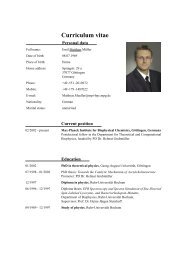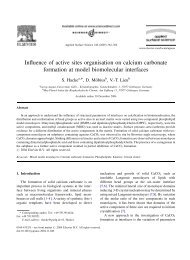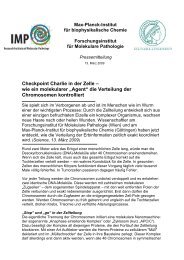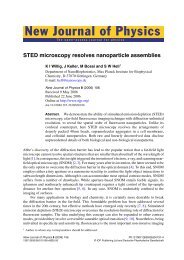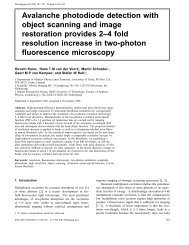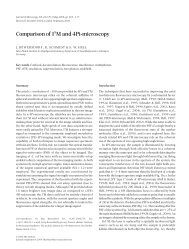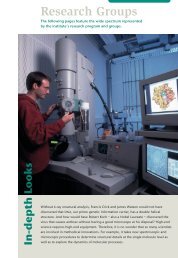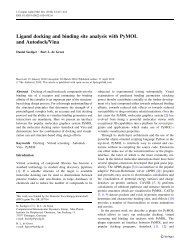Microscopy beyond imaging: space-resolved photochemistry and ...
Microscopy beyond imaging: space-resolved photochemistry and ...
Microscopy beyond imaging: space-resolved photochemistry and ...
- No tags were found...
You also want an ePaper? Increase the reach of your titles
YUMPU automatically turns print PDFs into web optimized ePapers that Google loves.
Fig. 3 Comparison of pulsed fluorescence excitation in bunches <strong>and</strong> atconstant repetition on a dye layer of Atto532. Various trains consisting ofbunches of 10 <strong>and</strong> 5 excitation pulses, arriving in time intervals of 2.5 mswere compared with a continuous 40 MHz pulse train. The timelines ofthe different pulse trains are schematically plotted in (A). The 10 <strong>and</strong>5 pulses were either applied with a repetition rate of 40 MHz with darkperiods filling up the remainder of the 2.5 ms, or evenly distributed intime with repetition rates of 4 <strong>and</strong> 2 MHz, respectively. Illumination witha total number of 5 ¥ 10 5 pulses <strong>and</strong> thus with total acquisition timesof 250 ms (5-bunch or 2 MHz) <strong>and</strong> 125 ms (10-bunch or 4 MHz)leaves differently photobleached dark spots (B) with levels of remainingfluorescence (inset B) <strong>and</strong> integrated fluorescence signal (C) depending onthe pulse intensity I p <strong>and</strong> the pulse timing of illumination. The levels ofremaining fluorescence (profile across the photobleached dye layer) <strong>and</strong>integrated fluorescence are plotted for I p = 2.9 MW cm -2 (arrow). Underthese conditions, the same number of pulses leads to the same levels ofphotobleaching <strong>and</strong> to a similar amount of integrated fluorescence signalat different I p (C), which changes upon addition of a triplet quencher(inset C), favoring excitation with a uniform repetition of pulses (circle).The lines in (C) are drawn for guidance.during illumination between the bunched <strong>and</strong> non-bunched modes(Fig. 3C).The time distance between succeeding pulses of 0.5 <strong>and</strong> 0.25 msof the continuous 2 <strong>and</strong> 4 MHz illumination mode, respectively,is smaller than the triplet lifetime of ~1 ms in the samplesinvestigated. 4 Only dark periods exceeding the average time neededfor triplet relaxation render ideal T-Rex illumination. 4 In our case,nearly ideal T-Rex illumination is attained only with interpulsetime differences of >2.5 ms, i.e. pulse repetition rates 400 kHz, i.e. to~1–2 MHz. The inset to Fig. 3C shows the fluorescence signal ofthe Atto532 layer in the presence of the triplet quencher againobtained for a total of 5 ¥ 10 5 pulses, for 5 pulses either bunchedor evenly distributed over the duty cycle of 2.5 ms. As before for the400 kHz T-Rex mode (Fig. 2), the (in this case ideal) 2 MHz T-Rexillumination is now favored over pulse bunching, resulting in about10% less signal of the bunched illumination as compared to itscontinuous counterpart. This difference can also be theoreticallyexplained for well determined kinetic parameters of rhodaminedyes, 18 specifically by a ~10-fold shorter triplet lifetime.This observation also highlights the dependence of our approachon environmental conditions. Since the lifetime of thetriplet state may change with experimental conditions such asadditives, concentration of molecular oxygen, or temperature,adjusting the timing of the experiment is required. Yet, the tripletlifetime is usually prolonged to >1 ms in biological samples orother mounting media, thus shifting the ideal T-Rex illuminationregime to repetition rates



